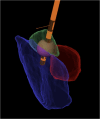Severe Refractory Obsessive Compulsive Disorder and Depression: Should We Consider Stereotactic Neurosurgery?
- PMID: 38463457
- PMCID: PMC10921944
- DOI: 10.2147/NDT.S407210
Severe Refractory Obsessive Compulsive Disorder and Depression: Should We Consider Stereotactic Neurosurgery?
Abstract
Functional neurosurgery involves modulation of activity within neural circuits that drive pathological activity. Neurologists and neurosurgeons have worked closely together, advancing the field for over a century, such that neurosurgical procedures for movement disorders are now accepted as "standard of care", benefiting hundreds of thousands of patients. As with movement disorders, some neuropsychiatric illnesses, including obsessive compulsive disorder and depression, can be framed as disorders of neural networks. Over the past two decades, evidence has accumulated that stereotactic neurosurgery can help some patients with mental disorders. Nevertheless, despite the availability of class I evidence for some interventions, there is a huge mismatch between the prevalence of severe refractory mental disorders and the number of referrals made to specialised functional neurosurgery services. This paper examines the historical trajectory of neurosurgery for movement and mental disorders. A review of neurosurgical techniques, including stereotactic radiofrequency ablation, gamma knife, deep brain stimulation, and magnetic resonance imaging guided focused ultrasound, explains the high degree of safety afforded by technological advances in the field. Evidence from clinical trials supporting functional neurosurgery for mental disorders, including obsessive compulsive disorder and depression, is presented. An improved understanding of modern functional neurosurgery should foster collaboration between psychiatry and neurosurgery, providing hope to patients whose symptoms are refractory to all other treatments.
Keywords: deep brain stimulation; focused ultrasound; major depression; obsessive compulsive disorder; stereotactic ablation; stereotactic neurosurgery.
© 2024 Zrinzo.
Conflict of interest statement
The author acts as a Consultant for Boston Scientific, Insightec, and Medtronic. The authors also reports Honoraria for educational activities from Medtronic, Boston Scientific, BrainLab, and InoMed. The author reports no other conflicts of interest in this work.
Figures




Similar articles
-
Deep Brain Stimulation for Obsessive-Compulsive Disorder and Depression.Annu Rev Neurosci. 2023 Jul 10;46:341-358. doi: 10.1146/annurev-neuro-110122-110434. Epub 2023 Apr 5. Annu Rev Neurosci. 2023. PMID: 37018916 Review.
-
Charting the road forward in psychiatric neurosurgery: proceedings of the 2016 American Society for Stereotactic and Functional Neurosurgery workshop on neuromodulation for psychiatric disorders.J Neurol Neurosurg Psychiatry. 2018 Aug;89(8):886-896. doi: 10.1136/jnnp-2017-317082. Epub 2018 Jan 25. J Neurol Neurosurg Psychiatry. 2018. PMID: 29371415 Free PMC article.
-
Clinical Perspectives on Psychiatric Neurosurgery.Stereotact Funct Neurosurg. 2019;97(5-6):391-398. doi: 10.1159/000505080. Epub 2020 Jan 17. Stereotact Funct Neurosurg. 2019. PMID: 31955163
-
Functional neurosurgery in the treatment of severe obsessive compulsive disorder and major depression: overview of disease circuits and therapeutic targeting for the clinician.Psychiatry (Edgmont). 2008 Sep;5(9):24-33. Psychiatry (Edgmont). 2008. PMID: 19727257 Free PMC article.
-
Lesion procedures in psychiatric neurosurgery.World Neurosurg. 2013 Sep-Oct;80(3-4):S31.e9-16. doi: 10.1016/j.wneu.2012.11.038. Epub 2012 Nov 14. World Neurosurg. 2013. PMID: 23159652 Review.
References
LinkOut - more resources
Full Text Sources
Research Materials
Miscellaneous

